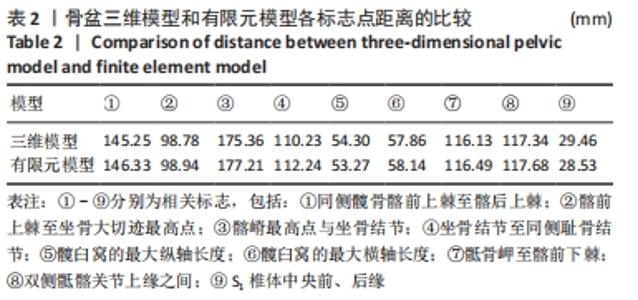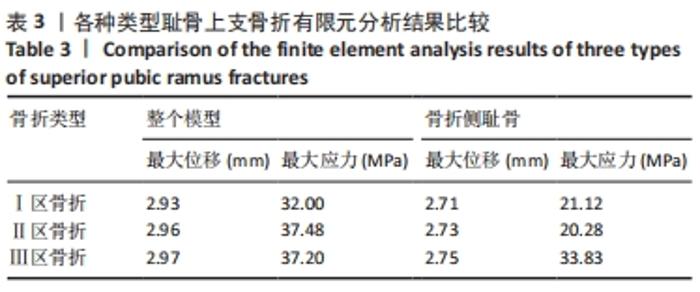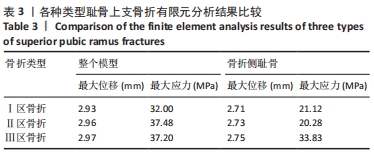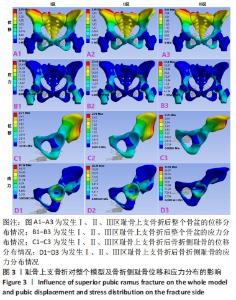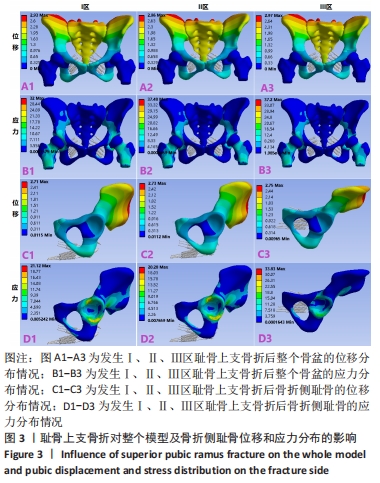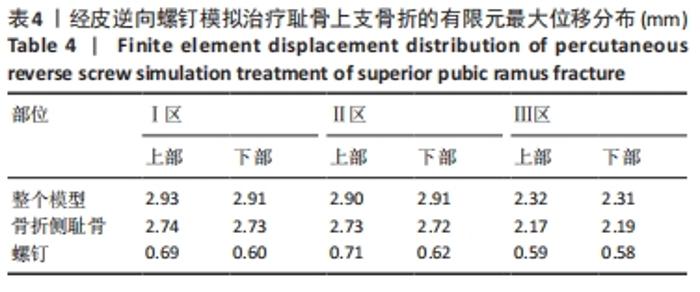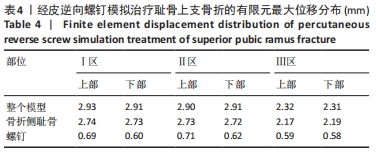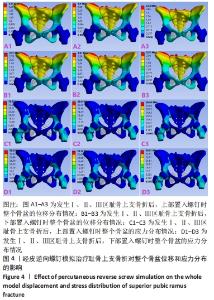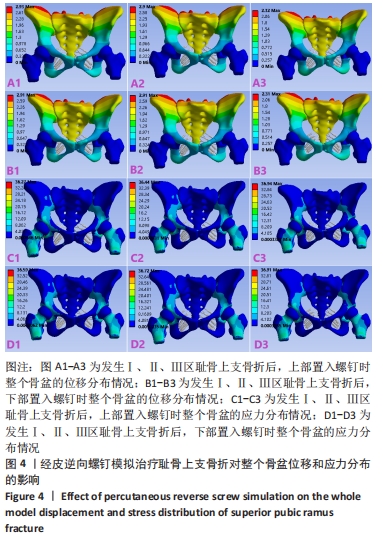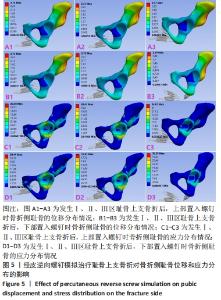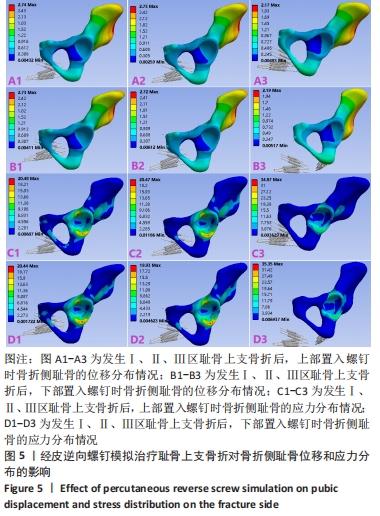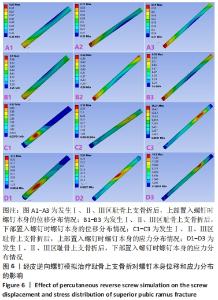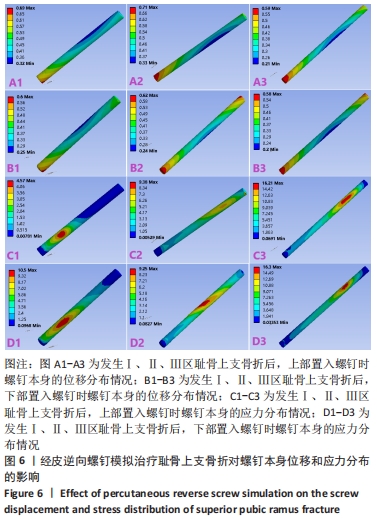Chinese Journal of Tissue Engineering Research ›› 2023, Vol. 27 ›› Issue (13): 1999-2004.doi: 10.12307/2023.254
Previous Articles Next Articles
Finite element analysis of percutaneous reverse screw for treatment of superior pubic ramus fracture
Lu Hui1, 2, Xu Ling1, Jiang Daixiang1, 2, Wu Qimei3, Liu Rong1, 2, 4
- 1School of Medicine, Wuhan University of Science and Technology, Wuhan 430081, Hubei Province, China; 2Institute of Medical Innovation and Transformation, 4Department of Orthopedics, Puren Hospital Affiliated to Wuhan University of Science and Technology, Wuhan 430080, Hubei Province, China; 3Wuhan Liu Sanwu Traditional Chinese Medicine Bone Injury Hospital, Wuhan 431400, Hubei Province, China
-
Received:2022-02-25Accepted:2022-04-23Online:2023-05-08Published:2022-08-11 -
Contact:Liu Rong, PhD, Associate professor, Associate chief physician, Master’s supervisor, School of Medicine, Wuhan University of Science and Technology, Wuhan 430081, Hubei Province, China; Institute of Medical Innovation and Transformation, and Department of Orthopedics, Puren Hospital Affiliated to Wuhan University of Science and Technology, Wuhan 430080, Hubei Province, China Wu Qimei, Associate chief physician, Wuhan Liu Sanwu Traditional Chinese Medicine Bone Injury Hospital, Wuhan 431400, Hubei Province, China -
About author:Lu Hui, Master candidate, School of Medicine, Wuhan University of Science and Technology, Wuhan 430081, Hubei Province, China; Institute of Medical Innovation and Transformation, Puren Hospital Affiliated to Wuhan University of Science and Technology, Wuhan 430080, Hubei Province, China Xu Ling, Master candidate, School of Medicine, Wuhan University of Science and Technology, Wuhan 430081, Hubei Province, China Lu Hui and Xu Ling contributed equally to this article. -
Supported by:Graduate Innovation and Entrepreneurship Fund Project of Wuhan University of Science and Technology in 2021, No. JCX2021116 (to LH); General Project of Hubei Provincial Key Laboratory Open Fund for Occupational Hazard Identification and Control in 2021, No. OHIC2021G06 (to LR); General Project of Hubei Provincial Natural Science Foundation of China, No. 2020CFB548 (to LR); Wuhan City Traditional Chinese Medicine and Integrated Traditional Chinese and Western Medicine General Project, No. WZ20C29 (to LR)
CLC Number:
Cite this article
Lu Hui, Xu Ling, Jiang Daixiang, Wu Qimei, Liu Rong. Finite element analysis of percutaneous reverse screw for treatment of superior pubic ramus fracture[J]. Chinese Journal of Tissue Engineering Research, 2023, 27(13): 1999-2004.
share this article
Add to citation manager EndNote|Reference Manager|ProCite|BibTeX|RefWorks

经皮逆向螺钉模拟治疗耻骨上支骨折的有限元最大应力分布见表5。从表中可以看出,发生Ⅰ区耻骨上支骨折后,如果进针点位于上部,对整个模型及螺钉产生的最大应力均低于下部,特别是对螺钉的应力变化,进针点位于上部、下部,螺钉最大应力分别为4.57 MPa、10.50 MPa,上部明显低于下部;说明Ⅰ区耻骨上支骨折,进针点位于上部效果更佳;发生Ⅱ区耻骨上支骨折后,进针点位于上部或者下部,对整个模型、骨折侧耻骨及螺钉产生的最大应力效果相当;说明Ⅱ区耻骨上支骨折,进针点位于上部或者下部效果相当。发生Ⅲ区耻骨上支骨折后,进针点位于上部或者下部效果相当。与图3中单纯发生3种类型耻骨上支骨折的模型相比,应力变化均明显降低,特别是对应耻骨下支的应力均减小,见图4-6。 "
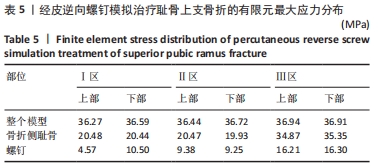
| [1] HUNG CC, WU JL, LI YT, et al. Minimally invasive treatment for anterior pelvic ring injuries with modified pedicle screw-rod fixation: a retrospective study. J Orthop Surg Res. 2018;13(1):238. [2] LI L, LU J, YANG L, et al. Stability evaluation of anterior external fixation in patient with unstable pelvic ring fracture: a finite element analysis. Ann Transl Med. 2019;7(14):303. [3] MARECEK GS, SCOLARO JA. Anterior Pelvic Ring: Introduction to Evaluation and Management. J Orthop Trauma. 2018;32 Suppl 6:S1-S3. [4] LEI J, ZHANG Y, WU G, et al. The Influence of Pelvic Ramus Fracture on the Stability of Fixed Pelvic Complex Fracture. Comput Math Methods Med. 2015;2015:790575. [5] STEVENSON AJ, SWARTMAN B, BUCKNILL AT. Percutaneous internal fixation of pelvic fractures. German version. Unfallchirurg. 2016;119:825-834. [6] QUERCETTI N, HORNE B, DIPAOLO Z, et al. Gun barrel view of the anterior pelvic ring for percutaneous anterior column or superior pubic ramus screw placement. Eur J Orthop Surg Traumatol. 2017;27:695-704. [7] LIU HS, DUAN SJ, LIU SD, et al. Robot-assisted percutaneous screw placement combined with pelvic internal fixator for minimally invasive treatment of unstable pelvic ring fractures. Int J Med Robot. 2018;14:e1927. [8] BANASZEK D, STARR AJ, LEFAIVRE KA. Technical Considerations and Fluoroscopy in Percutaneous Fixation of the Pelvis and Acetabulum. J Am Acad Orthop Surg. 2019;27:899-908. [9] ROUTT ML, SIMONIAN PT, GRUJIC L. The retrograde medullary superior pubic ramus screw for the treatment of anterior pelvic ring disruptions: a new technique. J Orthop Trauma. 1995;9:35-44. [10] FRANK M, DEDEK T, TRLICA J, et al. Percutaneous fixation of anterior column acetabular fractures--first experience. Acta Chir Orthop Traumatol Cech. 2010;77(2):99-104. [11] 王叙进,方诗元,徐磊,等. 有限元法分析不同内固定方法治疗复杂性骨盆骨折的力学稳定性[J]. 中国组织工程研究,2018,22(27):4354-4358. [12] 鲁辉,吴启梅,刘融. 单侧与双侧入路植入骨填充网袋治疗骨质疏松性椎体压缩性骨折的有限元分析与应用[J]. 中国组织工程研究,2023, 27(3):391-397. [13] LU H, JIANG D, WU Q, et al. A combination of digital design and three-dimensional printing to assist treatment of thoracolumbar compression fractures using percutaneous kyphoplasty. Global Health J. 2021;ISSN 2414-6447. [14] LU H, PENG H, PENG Z, et al. The Application of Digital Design Combined with 3D Printing Technology in Skin Flap Transplantation for Fingertip Defects during the COVID-19 Epidemic. Biomed Res Int. 2021;2021:5554500. [15] ZHAO Y, ZHANG S, SUN T, et al. Mechanical comparison between lengthened and short sacroiliac screws in sacral fracture fixation: a finite element analysis.Orthop Traumatol Surg Res. 2013;99(5):601-606. [16] DALSTRA M, HUISKES R. Load transfer across the pelvic bone.J Biomech. 1995;28(6):715-724. [17] PHILLIPS AT, PANKAJ P, HOWIE CR, et al. Finite element modelling of the pelvis: inclusion of muscular and ligamentous boundary conditions. Med Eng Phys. 2007;29(2):739-748. [18] 王琦. 张力带钢板治疗不稳定骨盆骨折的生物力学性能评价[J]. 中国组织工程研究,2017,21(11):1737-1741. [19] ZHENG N, WATSON LG, YONG-HING K. Biomechanical modelling of the human sacroiliac joint.Med Biol Eng Comput. 1997;35(2):77-82. [20] 钟子毅, 童凯, 谢献进, 等. 髋臼T形骨折不同内固定方式的有限元分析[J]. 中华创伤骨科杂志,2018,20(6):515-522. [21] 潘昌武, 刘曦明, 蔡贤华, 等. 微型联合重建接骨板内固定治疗髋臼后壁骨折坐位下的三维有限元分析[J]. 中国矫形外科杂志,2015,23(2): 160-164. [22] STARR AJ, NAKATANI T, REINERT CM, et al. Superior pubic ramus fractures fixed with percutaneous screws: what predicts fixation failure? J Orthop Trauma. 2008;22(2):81-87. [23] MURPHY WS, YUN HH, HAYDEN B, et al. The Safe Zone Range for Cup Anteversion Is Narrower Than for Inclination in THA. Clin Orthop Relat Res. 2018;476(2):325-335. [24] OCHS BG, STUBY FM, STOECKLE U, et al. Virtual mapping of 260 three-dimensional hemipelvises to analyse gender-specific differences in minimally invasive retrograde lag screw placement in the posterior acetabular column using the anterior pelvic and midsagittal plane as reference. BMC Musculoskelet Disord. 2015;16:240. [25] 王尧,张雪松,罗春材,等. 国人成人经第1及第2骶椎骶髂骨螺钉置钉钉道差异的CT测量[J]. 解放军医学院学报,2016,37(6):591-594,606. [26] 王庆贤, 张英泽, 潘进社, 等. 耻骨上支逆行拉力螺钉内固定的应用解剖学研究[J]. 中国临床解剖学杂志,2005,23(6):617-619. [27] SUZUKI T, SOMA K, SHINDO M, et al. Anatomic study for pubic medullary screw insertion. J Orthop Surg (Hong Kong). 2008;16:321-325. [28] 赵勇, 马玉鹏, 邹德鑫, 等. 三种微创内固定治疗骨盆前环双侧骨折的生物力学比较[J]. 中华实验外科杂志,2020,37(11):2110-2113. [29] 张永强,章莹,夏远军, 等. 髋臼部T形骨折四种不同内固定方式的生物力学有限元分析[J]. 中国临床解剖学杂志,2017,35(3):312-317. [30] 柳超,王前,张杰峰, 等. 不同内固定手术方式治疗寰枢椎复合骨折稳定性的有限元分析[J]. 中国脊柱脊髓杂志,2015,25(10):904-911. [31] MISKIMINS R, DECKER M, HOBBY B, et al. Complications of pelvic ring fixation in patients requiring laparotomy.J Surg Res. 2015;199:244-248. [32] DALSTRA M, HUISKES R, VAN ERNING L. Development and validation of a three-dimensional finite element model of the pelvic bone. J Biomech Eng. 1995;117:272-278. [33] ANDERSON AE, PETERS CL, TUTTLE BD, et al. Subject-specific finite element model of the pelvis: development, validation and sensitivity studies. J Biomech Eng. 2005;127:364-373. [34] MASLOV L, BOROVKOV A, MASLOVA I, et al. Finite Element Analysis of Customized Acetabular Implant and Bone after Pelvic Tumour Resection throughout the Gait Cycle. Materials (Basel). 2021;14(22):7066. [35] SALO Z, KREDER H, WHYNE CM. The Impact of an Open-Book Pelvic Ring Injury on Bone Strain: Validation of a Finite Element Model and Analysis Within the Gait Cycle. J Biomech Eng. 2021;143(7):071005. [36] ZHANG BF, WANG J, ZHANG YM, et al. The morphological mapping of lateral compression type 1 pelvic fracture and pelvic ring stability classification: a finite element analysis. J Orthop Surg Res. 2021;16(1):675. [37] 贺宇,周东生,邱贵兴,等. 四种内固定方式治疗耻骨联合分离生物力学特性的有限元分析[J]. 中华创伤骨科杂志,2017,19(4):317-322. [38] GUO HZ, TANG YC, GUO DQ, et al. Biomechanical evaluation of four different posterior instrumentation techniques for single-level transforaminal lumbar interbody fusion: a finite element analysis. Am J Transl Res. 2020;12:6160-6169. [39] LU H, ZHANG Q, DING F, et al. Finite Element Analysis of Unilateral versus Bipedicular Bone-Filling Mesh Container for the Management of Osteoporotic Compression Fractures. Biomed Res Int. 2022;2022:6850089. |
| [1] | Zhong Yizheng, Huang Peizhen, Cai Qunbin, Zheng Liqin, He Xingpeng, Dong Hang. Microstructural indexes that determine the trabecular bone maximum stress of micro-finite element models [J]. Chinese Journal of Tissue Engineering Research, 2023, 27(9): 1313-1318. |
| [2] | Wu Taoguang, Nie Shaobo, Chen Hua, Zhu Zhengguo, Qi Lin, Tang Peifu. Biomechanical characteristics of a new multi-dimensional cross locking plate in the treatment of subtrochanteric nonunion [J]. Chinese Journal of Tissue Engineering Research, 2023, 27(9): 1330-1334. |
| [3] | Peng Zhixin, Yan Wengang, Wang Kun, Zhang Zhenjiang. Finite element analysis and structural optimization design of 3D printed forearm braces [J]. Chinese Journal of Tissue Engineering Research, 2023, 27(9): 1340-1345. |
| [4] | Wu Tianliang, Tao Xiuxia, Xu Hongguang. Influence of different bone mineral densities on cage subsidence after stand-alone oblique lateral interbody fusion: three-dimensional finite element analysis [J]. Chinese Journal of Tissue Engineering Research, 2023, 27(9): 1352-1358. |
| [5] | Liu Jinyu, Zhang Hanshuo, Cui Hongpeng, Pan Lingzhi, Zhao Boran, Li Fei, Ding Yu. Finite element biomechanical analysis of minimally invasive treatment of cervical spondylotic myelopathy and accurate exercise rehabilitation [J]. Chinese Journal of Tissue Engineering Research, 2023, 27(9): 1359-1364. |
| [6] | He Yujie, Kang Zhijie, Xue Mingming, Jin Feng, Li Zhijun, Wang Xing, Xu Yangyang, Gao Mingjie, Li Jiawei, Li Xiaohe, Wang Haiyan. Finite element analysis of transarticular screw fixation of adolescent thoracic vertebra [J]. Chinese Journal of Tissue Engineering Research, 2023, 27(9): 1365-1370. |
| [7] | Wen Xinghua, Ding Huanwen, Cheng Kai, Yan Xiaonan, Peng Yuanhao, Wang Yuning, Liu Kang, Zhang Huiwu. Three-dimensional finite element model analysis of intramedullary nailing fixation design for large femoral defects in Beagle dogs [J]. Chinese Journal of Tissue Engineering Research, 2023, 27(9): 1371-1376. |
| [8] | Liu Jiaxin, Jia Peng, Men Yutao, Liu Lu, Wang Yeming, Ye Jinduo. Design and optimization of bone trabecular structure with triply periodic minimal surfaces [J]. Chinese Journal of Tissue Engineering Research, 2023, 27(7): 992-997. |
| [9] | Zhu Lin, Gu Weiping, Wang Can, Chen Gang. Biomechanical analysis of All-on-Four and pterygomaxillary implants under different maxillary bone conditions [J]. Chinese Journal of Tissue Engineering Research, 2023, 27(7): 985-991. |
| [10] | Sun Jiangwei, Wang Junxiang, Baibujiafu·Yellisi, Dai Huijuan, Nijati·Turson. Three-dimensional finite element analysis of stress distribution in different smooth collar implants [J]. Chinese Journal of Tissue Engineering Research, 2023, 27(7): 1004-1011. |
| [11] | Jiang Yifang, Cai Qimin, Chu Zhengyi, Qin Min, Shen Yurong, Gu Yuanping. Simulation analysis of stress distribution of NRT FILES in curved root canals [J]. Chinese Journal of Tissue Engineering Research, 2023, 27(7): 1038-1042. |
| [12] | Li Huiqin, Wang Chunjuan, Wang Yu, Wang Weifeng, Chen Dinggen, Li Na. Clear aligner orthodontic therapy of rotated mandibular teeth with different shapes: a three-dimensional finite element analysis [J]. Chinese Journal of Tissue Engineering Research, 2023, 27(7): 1050-1054. |
| [13] | Liu Qinghua, Cai Yongqiang, Jin Feng, Yu Jinghong, Wang Haiyan, Zhang Yunfeng, Wang Lidong, Li Jiawei, Wang Xing, He Yujie, Dai Lina, Wang Jianzhong, Wu Chao, Tong Ling, Kang Zhijie, Li Zhijun, Li Xiaohe. Finite element model of the 12-year-old child whole cervical spine: establishment and validity verification based on CT data [J]. Chinese Journal of Tissue Engineering Research, 2023, 27(4): 500-504. |
| [14] | Li Yaping, Liu Hong, Gao Zhen, Chen Xiaolin, Huang Wujie, Jiang Zheng. Three-dimensional motion analysis of lower limb biomechanical performance in Tai Chi practitioners accompanied by knee joint pain [J]. Chinese Journal of Tissue Engineering Research, 2023, 27(4): 520-526. |
| [15] | Li Shihao, Li Qi, Li Zhen, Zhang Yuanyuan, Liu Miaomiao, Ouyang Yi, Xu Weiguo. Plantar pressure and gait analysis in patients with anterior cruciate ligament injury and reconstruction [J]. Chinese Journal of Tissue Engineering Research, 2023, 27(4): 626-631. |
| Viewed | ||||||
|
Full text |
|
|||||
|
Abstract |
|
|||||
